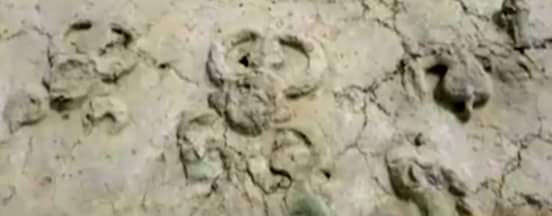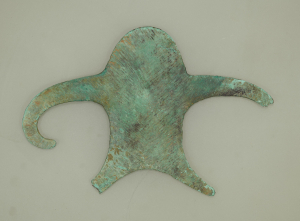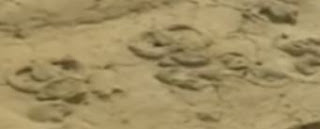https://tinyurl.com/y98powrm
The golden anthropomorph discovered in Sanauli in 2006-7 excavation, compares with three types of bronze anthropomorphs found in many parts of Eurasiaright from the days of the civilization in Lothal. See:
Anthropomorphs four types on Indus Script signify metal-, mint-worker, seafaring merchant, karṇika 'supercargo, helmsman', koṭiya 'dhow' http://tinyurl.com/zgzv5e5
Four types of anthropomorphs have been discovered so far from the Sarasvati-Ganga River Basins.
All types of anthropomorphs are metalwork professional calling cards, dhamma samjñā responsibility signifiers to create the wealth of the nation, the commonwealth.
Type I Anthropomorph: fish inscribed on chest of ram with curved horns, human body, spread legs
Sheorajpur (Inv. No O.37a, State Museum of Lucknow.
ayo 'fish' mẽḍhā 'curved horn' meḍḍha 'ram' rebus: ayo meḍh 'metal merchant' ayo mēdhā 'metal expert' karṇika 'spread legs' rebus: karṇika कर्णिक 'steersman'.
Thus, Type I anthropomorph signifies a steersman (of seafaring vessel), metals expert, metals merchant.
Type II Anthropomorph. Seated position of Anthropomorph.
Seated position if signifying penance, the rebus reading is: kamaDha 'penance' rebus: kammaTa 'mint, coiner, coinage.
meḍh 'iron' mRdu 'iron' med 'copper' (Slavic) PLUS meḍh 'merchant' mēdhā 'expert'
PLUS kamaDha 'penance' rebus: kammaTa 'mint, coiner, coinage'. '
Thus, Type II anthropormph signifies a copper/iron merchant with mint. Photograph of one of the 6 Madarpur anhropomorphs (After Fig. 1 in: R. Balasubramaniam, et al, 2002, Studies on ancient Indian OCP period copper, in: IJHS 37.1, pp. 1-15). http://www.dli.gov.in/rawdataupload/upload/insa/INSA_1/2000616d_1.pdf
eraka 'upraised arm' rebus: eraka 'copper'.
ayo meḍh 'metal merchant' ayo mēdhā 'metal expert'
PLUS kamaDha 'penance' rebus: kammaTa 'mint, coiner, coinage'.
Type IV Anthropormorph standing inscribed with one-horned young bull and ligatured with head of a boar
Type III anthropomorph with Indus Script hieroglyphs signifies a copper worker, metals merchant with mint A composite copper anthropomorphic figure along with a copper sword was found by Dr. Sanjay Manjul, Director, Institute of Archaeology at the Central Antiquity Section, ASI, Purana Qila in 2005. This composite copper anthropomorph is a solitary example in the copper hoard depicting a Varaha'boar' head. The Anthropomorphic figure, its inscription and animal motif that it bears, illustrate the continuity between the Harappan and Early Historical period.
Hieroglyph: mẽḍhā 'curved horn', miṇḍāl 'markhor' (Tōrwālī) meḍho a ram, a sheep; mē̃ḍh 'ram' Rebus: Медь [Med'] (Russian, Slavic) 'copper'.
मृदु, मृदा--कर 'iron, thunderbolt'
मृदु mṛdu 'a kind of iron'मृदु-कार्ष्णायसम्,-कृष्णायसम् soft-iron, lead. Santali glosses.
Santali glosses.
Sa. <i>mE~R~hE~'d</i> `iron'. ! <i>mE~RhE~d</i>(M).
Ma. <i>mErhE'd</i> `iron'.
Mu. <i>mERE'd</i> `iron'.
~ <i>mE~R~E~'d</i> `iron'. ! <i>mENhEd</i>(M).
Ho <i>meD</i> `iron'.
Bj. <i>merhd</i>(Hunter) `iron'.
KW <i>mENhEd</i>
@(V168,M080)
— Slavic glosses for 'copper'
Мед [Med]Bulgarian
Bakar Bosnian
Медзь [medz']Belarusian
Měď Czech
Bakar Croatian
KòperKashubian
Бакар [Bakar]Macedonian
Miedź Polish
Медь [Med']Russian
Meď Slovak
BakerSlovenian
Бакар [Bakar]Serbian
Мідь [mid'] Ukrainian[unquote]
Miedź, med' (Northern Slavic, Altaic) 'copper'.
One suggestion is that corruptions from the German "Schmied", "Geschmeide" = jewelry. Schmied, a smith (of tin, gold, silver, or other metal)(German) result in med ‘copper’.
ayo meḍh 'metal merchant' ayo mēdhā 'metal expert'
PLUS karṇika 'spread legs' rebus: karṇika कर्णिक 'steersman'.
barāh, baḍhi 'boar' vāḍhī, bari, barea 'merchant' bārakaśa 'seafaring vessel'.
eka-shingi 'one-masted' koḍiya ‘young bull’, koṭiya 'dhow', kũdār 'turner, brass-worker'.
Thus, Type IV anthropomorph with Indus Script hieroglyphs signifies a steersman/helmsman, metals expert, metals turner (brass worker), metals merchant with a dhow, seafaring vessel.
The golden anthropomorph dated to ca. 2000 BCE signifies a standing persin with spread legs. This is an Indus Script hieroglyph read rebus: कर्णक kárṇaka, कर्णकm. du. the two legs spread out AV. xx , 133 , 3 Rebus: कर्णिन्् karn-ín having ears; barbed; m. helmsman. कर्ण kárna â, î) -dhâra, m. helmsman; sailor: -tâ, f. helmsmanship (Monier-Williams) karṇadhāra m. ʻ helmsman ʼ Suśr. [kárṇa -- , dhāra -- 1] Pa. kaṇṇadhāra -- m. ʻ helmsman ʼ; Pk. kaṇṇahāra -- m. ʻ helmsman, sailor ʼ; H. kanahār m. ʻ helmsman, fisherman ʼ. (CDIAL 2826)
Continuum of Indus Script (ca. 2000 BCE) on eight copper anthropomorphs discovered in Baghpat, signify wealth accounting metalwork ledgers https://tinyurl.com/y7f3k8q4 The hypertexts are read rebus: The hypertext reads: dhangar 'bull' rebus: dhangar 'blacksmith'; lohkarṇīka 'metal (guild) helmsman (master)'. It may also signify lohkarṇī 'metal supercargo(a representative of the ship's owner on board a merchant ship, responsible for overseeing the cargo and its sale.).' mũh 'a face' in Indus Script Cipher signifies mũh, muhã 'ingot' or muhã 'quantity of metal produced at one time in a native smelting furnace.'
Continuum of Indus Script (ca. 2000 BCE) on eight copper anthropomorphs discovered in Baghpat, signify wealth accounting metalwork ledgers https://tinyurl.com/y7f3k8q4 The hypertexts are read rebus: The hypertext reads: dhangar 'bull' rebus: dhangar 'blacksmith'; lohkarṇīka 'metal (guild) helmsman (master)'. It may also signify lohkarṇī 'metal supercargo(a representative of the ship's owner on board a merchant ship, responsible for overseeing the cargo and its sale.).' mũh 'a face' in Indus Script Cipher signifies mũh, muhã 'ingot' or muhã 'quantity of metal produced at one time in a native smelting furnace.'
Gold anthropomorph, Sanauli, Baghpat. This anthropomorph compares with eight copper anthropomorphs discovered in 2018 by the team of Sanjay Kumar Manjul proclaimed in bas-relief on the lid of a wooden coffin.

Sanauli Excavations – 2006-2007
 Sanauli, tehsil Barot, district Baghpat, U.P. is under excavation by the ASI since September 2005. The site was a chance discovery while locals undertook levelling operation for agricultural purposes. Subsequently, ASI identified the site as a prominent cemetery site of late Harappan period (early 2nd millennium B.C.).
Sanauli, tehsil Barot, district Baghpat, U.P. is under excavation by the ASI since September 2005. The site was a chance discovery while locals undertook levelling operation for agricultural purposes. Subsequently, ASI identified the site as a prominent cemetery site of late Harappan period (early 2nd millennium B.C.).
The excavations have so far brought to light 125 burials all in north-south orientation; most of them are primary burials. Evidence for secondary and multiple burials have also been noted. In some burials, animal’s bones are also found next to the human bones. The burial goods consisted of vases (often placed near the head, and in odd numbers, 3, 5, 7, 9, 11, etc.), bowls, dish-on-stand (mostly placed below the hip), antenna swords and sheath of copper, TC figurines, etc. A good number of personal jewellery in the form of gold and copper bangles, beads of semi-precious stones (two necklaces of long barrel shape) and steatite, etc. are also found. The antenna swords from these burials have a striking resemblance with that of the copper hoards specimens.
Remains of a brick wall (50 X 50 X 24 cm) along with two dish-on-stands and a flat copper container (violin shaped) with nearly 35 arrow-head shaped copper objects placed in rows are among the important finds. Similar to the copper container, another symbolic burial yielded a careful arrangement of steatite beads in the shape of violin with a copper sheath placed across. These specimens may represent actual human beings. http://121.242.207.115/asi.nic.in/sanauli/

Skeletal remains of an individual with the upper body turned towards the left

Skeletal remains along with burial pots, second millennium BCE

General view of the excavated Burials, Sanauli, second millennium BCE

General view of the excavated Burials, Sanauli, second millennium BCE

General view of the excavated Burials, Sanauli, second millennium BC2
General view of the excavated Burials, Sanauli, second millennium BC

General view of the excavated Burials, Sanauli, second millennium BC
General view of the excavated Burials, Sanauli, second millennium BC1

General view of the excavated Burials, Sanauli, second millennium BC

Faience beads, second millennium BC02

Faience beads, second millennium BC

Faience bead, second millennium BC

Bone point, second millennium BC

Beads of semi-precious stones from various burials, second millennium BC

Association of an antenna sword and sheath of copper along with burial

Association of an antenna sword and sheath of copper along with burial 3

Association of an antenna sword and sheath of copper along with burial 1








